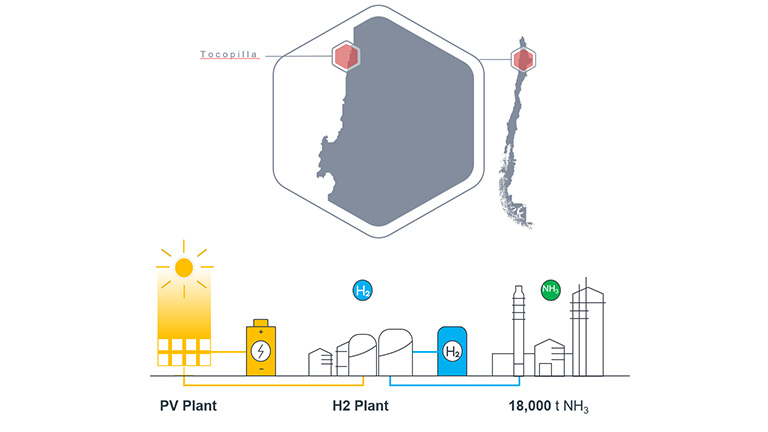Casa dos Ventos, Comerc and the Transhydrogen Alliance (THA) will continue development of a 2.2 million-tonne-per-year electrolytic ammonia export project at the Port of Pecém in northern Brazil. The country’s renewables-heavy grid will power 2.4 GW of electrolysis capacity, with exports to Rotterdam to start in 2026. THA founding member Proton Ventures recently selected an engineering partner to perform FEED work for the Pecém plant, and was also awarded a construction contract by OCP Group for two world-scale ammonia storage tanks in Morocco.
Brazil
Japanese giants explore renewable ammonia production in Chile
As part of the HyEx project, Mitsui & Co., Toyo Engineering and Enaex will develop a solar-powered, 18,000 tonnes-per-year renewable ammonia plant in Tocopilla, northern Chile. Just outside of Tocopilla, Sumitomo and Chilean transmission utility Colbún have teamed up to explore renewable ammonia production & export. The pair will also assess million-tonne-per-year production in Chile’s south. Also in South America, Proton Ventures have contracted Fitchner to assess the feasibility of planned renewable production projects.
Brazil’s first electrolysis-based ammonia plant takes shape
Brazil’s largest fertiliser producer Unigel has launched the country’s first industrial-scale electrolytic hydrogen & ammonia project. 60 MW of grid-connected, thyssenkrupp nucera electrolysers will feed the production 60,000 tonnes per year of ammonia. An existing ammonia production plant in Camaçari, Bahia province will provide the foundation for the project, which seeks to leverage the high share of renewable electricity in Brazil’s national grid. In other South American news, Uruguay’s officially-released Green Hydrogen Roadmap sets out ambitious decarbonisation goals. Green ammonia has a role both as an export commodity and for domestic use.
Producing cheap, clean hydrogen: new updates
Three new updates this week:
1. A team at Durham University has shown that a massive scale-up of PEM electrolyser manufacturing capability can slash the capital costs of producing electrolyser units by up to 70%.
2. A team from the University of Campinas has proposed more focus on electrolysis of waste and seawater to produce hydrogen, avoiding direct competition between drinking water and hydrogen production.
3. A team from the Australian National University has demonstrated a new pathway forward for hydrogen production directly from sunlight by demonstrating a stable, efficient photocatalyst.









